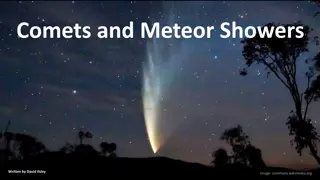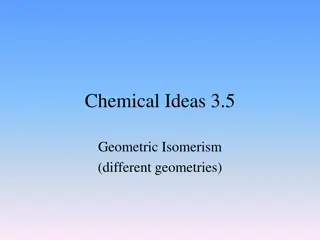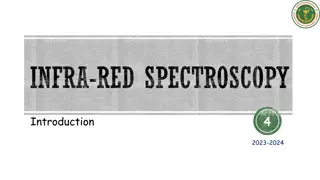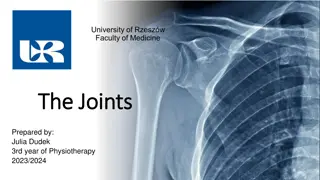Understanding Hillslopes and Their Significance in Geomorphology
Hillslopes are angular inclinations of terrain between hilltops and valley bottoms, shaped by geological structures, climate, vegetation cover, and denudational processes. They are key geomorphic features in fluvial drainage basins, playing a crucial role in landscape formation and water/sediment transfer to streams. The study of hillslopes is essential for classifying, developing, and understanding the evolution of landscapes.
Download Presentation
Please find below an Image/Link to download the presentation.
The content on the website is provided AS IS for your information and personal use only. It may not be sold, licensed, or shared on other websites without obtaining consent from the author. Download presentation by click this link. If you encounter any issues during the download, it is possible that the publisher has removed the file from their server.
Presentation Transcript
What do you mean by hillslope? Slope can be defined as angular inclinations of terrain between hill tops and valley bottoms. It s a product of a combination of many causative factors like geological structure, climate, vegetation cover, drainage texture and frequency, dissection index, relative reliefs and of course denudational processes, including weathering, mass wasting and mass movements of rock wastes, erosion and transportation of eroded materials downslope etc. They are significant geomorphic attributes in the study of landforms of fluvially originated drainage basin.
Definition Slope is, thus, upward or downward inclination of surface between hills and valleys and form most significant aspect of landscape assemblages. Except plains and terraces slopes are always perceptible mountainous regions. and are more in significant
Significance of study of hillslope The morphological characteristics of a region are determined by slopes of that region because physical landscapes are the result of combinations of slopes. Not only this, slopes introduce variations and complexity in the landscape of a region. Therefore, the study of different aspects of slopes has always been a focal theme in geomorphology. The study of slope in geomorphology is given more importance because, not only slopes do comprise the greater part of the landscape, but as an integral part of the drainage system they provide water and sediment to streams. Therefore, hillslopes are an important component of the complex landscape that forms a drainage basin. The study of slope involves classification, development and evolution of hillslopes.
Classification of Slopes There is marked variation in opinions regarding the classification of hillslopes because of confusions regarding the elements (segments) and form of slopes. Convex, free face, rectilinear and concave segments are in fact elements of hillslope profile, but a few geomorphologists have recognized them as types of hillslopes. It may be pointed out that no hillslope may be only either rectilinear (straight), or convex or concave rather it comprises more than one element (segment), though one element may be most extensive and dominant. Generally, some geomorphologists classify slopes for simplification into cliff slope (free face or scarp slope), rectilinear or straight slope, convex slope and concave slope, and if more than one forms are present, they call them composite slope. But this classification is not justiciable because these are not types (slope forms) rather these are slope elements (slope segments). Let us examine the characteristics of slope elements.
Slope Elements If the longitudinal profile of a hill slope or coastal slope is considered, it becomes apparent that there is no uniformity in the slope profile in relation to slope angles from hill tops to valley floors or from cliff crest to sea shore. The entire hill slope is punctuated by the presence of convexity, concavity, rectilinearity and free face. These distinctive segments of slope profile are called slope elements or slope segments. It is not always necessary that all the slope profiles will comprise all the four elements, but an ideal hillslope profile is that which consists of summital convexity, free-face, rectilinearity and basal concavity. The existence of free face (cliff) elements depends on the presence of resistant strata (in the case of hillslope) or undercutting (cliffing) at the slope base (in the case of coastal slope).
Slope Elements Summital Convexity the convex segment is found at the hill crest (hill top) and this element is called summital convexity (or simply convex element). Convex slope, if convex element dominates the hillslope profile, is also called as waxing slope because it grows in height upward and in dimension downward, but it must be remembered not all convex slopes necessarily grow in height and dimensions (size). Most of the summital convexity develops because of denudational processes e.g. rainwash or soil creep, this is why convex slope is also called upper wash.
Free Face free face element of hillslope represents wall-like precipitous slope of bare rocks and is devoid of any debris. The slope is so steep and precipitous that no weathered materials can rest on it. The element or segment is called slope of derivation because there is instantaneous downslope transport of materials. The free face element is subjected to back wasting which facilitates parallel retreat of this element.
Rectilinear Element the straight or linear segment of hillslope profile between upper free face and lower concave element is called linear element. It is also termed as constant or uniform or regular slope because of uniform nature of slope angle. Because of the presence of rock debris this segment is called debris slope.
Convex Element the basal segment of an ideal hillslope profile is always characterized by concave element. The slope angle decreases as the segment of basal concavity increases (in length). That is why this segment is called waning slope. This element is also called valley floor basement slope or lower wash slope. Basal concavity is generally originated because of active denudation mainly by rain wash, rill and gully erosion. This segment may be covered with debris or may be of bare rocks.
It may be pointed out that theoretically it is conceived that an ideal hillslope profile consists of all the four elements viz. summital convexity, free face, rectilinear and basal concavity but in practice it is not always possible. Any slope profile consists of at least two elements and instead of mono-element slope there is composite or compound slope which may be of different types depending on varying combinations of slope elements. Classification based on slope elements Convexo-concave slope Convexo-rectilinear-concave slope Free face-rectilinear-concave slope Convex-rectilinear-free face-rectilinear concave slope Convex-rectilinear-free face slope and so on.
Genetic classification of hillslopes involves the mode of their origin and development. Thus, based on mode of genesis, hillslopes may be classified into three types- Genetic Classification Tectonic Slope Erosional Slope Slope of Accumulation
Quantitative classification involves classification of slopes into certain types based on slope angles which are derived from topographical maps and aerial photographs or based on measurement of slope angles with suitable instruments in the field. A. Young classified slopes on the basis of slope angles of slope profiles into seven major categories as follows- Level to gentle slope Quantitative Classification Level slope (0 - 0.5 ) Almost level slope (0.5 - 1.0 ) Very gentle slope (1.0 - 2.0 ) Gentle slope (2.0 - 5.0 )
Gentle slope (2.0 - 5.0) Moderate slope (5.0 - 10.0 ) Moderately steep slope (10.0 - 18.0 ) Steep slope (18.0 - 30.0 ) Quantitative Classification Very steep slope (30.0 - 45.0 ) Precipitous to vertical slope (45.0 - 90.0 ) Precipitous slope (45.0 - 70.0 ) Wall-like slope (70.0 - 90.0 )
Young (1972) mentioned that all the theories of slope development may be grouped in 3 broad categories viz. (i) Slope decline theory (ii) Slope replacement theory, and (iii) parallel retreat theory. Slope decline theory the steepest part of the slope progressively decreases in angle, accompanied by the development of a convexity and concavity. Slope replacement theory the maximum angle decreases through replacement from below by gentler slopes, causing the greater part of the profile to become occupied by the concavity. The concavity may be either smoothly curved or segmented. Parallel retreat theory the maximum angle remains constant, the absolute lengths of all parts of the slope except the concavity remain constant, and the concavity increases in length; the angle at any point on the concavity decreases.
Davis theory of slope decline has its roots in his earlier works viz. the grading of mountain slopes (1898), the geographical cycle (1899) etc. Like the cyclic development of landscapes Davis hillslope and valley side slope also undergo the process of cyclic development wherein there is progressive decline in slope angle and sequential change in slope from youth (convex form) through mature (rectilinear or uniform slope form) to old (concave form) stages. Slope decline theory of W. M. Davis Steep convex slopes evolve during youth stage of cycle of erosion because of active downcutting resulting into valley deepening and weathering processes. There is very limited slope retreat and practically there is no decline in slope angle rather it is increased.
Lateral erosion dominates over vertical erosion and divide summits are eroded (down wasting of water divides) during mature stage. Thus, down wasting of water divides results in decrease in slope angle (and hence slope decline) and slope profile of smooth curve formed. Slope becomes graded because at each point on the slope profile the gradient is such that weathered debris may be transported (removed) downslope. Because of continued lateral erosion and down wasting of water divides (and hence marked lowering of relief) there is marked slope decline in old stage so that the general slope form becomes concave and nowhere slope angle becomes more than 5 degree.
Davisian model of slope evolution includes three aspects via. rounded convexity of hill tops and interfluves, graded waste sheets on slope profiles and graded valley sides, which Davis tried to explain in terms of their significance and origin. According to Davis summital rounded convexity results from the action of soil creep in humid climate. He described qualitatively the mechanism of movement in creep, by alternate dilation and contraction of the soil under the influence of gravity. Soil creep is motivated because of rainwash, the intensity of which increases downslope. Creep (soil creep) produces rounded contours and is responsible for convex profile of divides.
The weathered materials existing on slope profiles (both hillslope and valley side slopes) has been termed as waste sheet which constantly moves downslope by the agents of transportation under the influence of gravity force. When transporting capacity of the transporting agents (actual available energy of transporting agents) equals the required force to transport the materials i.e. when the available energy for transportation of debris and the work to be done (debris to be transported downslope) are equally balanced, the layer of the waste of debris on slope profile is called graded waste sheet.
Criticism - Like cycle of erosion Davis model of slope evolution also depends on crustal stability for longer duration after the initiation of cycle and which is a rare thing a far as the dynamics of the earth s crust is concerned which makes it susceptible to criticism. And also because of its consonant with its relation to the cycle of erosion, the theory has been implications that slope form is time- dependent. criticized on its

















































